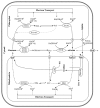Role of proline under changing environments: a review - PubMed (original) (raw)
Review
. 2012 Nov;7(11):1456-66.
doi: 10.4161/psb.21949. Epub 2012 Sep 5.
Affiliations
- PMID: 22951402
- PMCID: PMC3548871
- DOI: 10.4161/psb.21949
Review
Role of proline under changing environments: a review
Shamsul Hayat et al. Plant Signal Behav. 2012 Nov.
Abstract
When exposed to stressful conditions, plants accumulate an array of metabolites, particularly amino acids. Amino acids have traditionally been considered as precursors to and constituents of proteins, and play an important role in plant metabolism and development. A large body of data suggests a positive correlation between proline accumulation and plant stress. Proline, an amino acid, plays a highly beneficial role in plants exposed to various stress conditions. Besides acting as an excellent osmolyte, proline plays three major roles during stress, i.e., as a metal chelator, an antioxidative defense molecule and a signaling molecule. Review of the literature indicates that a stressful environment results in an overproduction of proline in plants which in turn imparts stress tolerance by maintaining cell turgor or osmotic balance; stabilizing membranes thereby preventing electrolyte leakage; and bringing concentrations of reactive oxygen species (ROS) within normal ranges, thus preventing oxidative burst in plants. Reports indicate enhanced stress tolerance when proline is supplied exogenously at low concentrations. However, some reports indicate toxic effects of proline when supplied exogenously at higher concentrations. In this article, we review and discuss the effects of exogenous proline on plants exposed to various abiotic stresses. Numerous examples of successful application of exogenous proline to improve stress tolerance are presented. The roles played by exogenous proline under varying environments have been critically examined and reviewed.
Keywords: abiotic stress; antioxidant system; proline.
Figures
Figure 1. Proline metabolism in higher plants. Solid lines represents the biosynthetic pathway while catabolic pathways are shown with dashed lines. BAC, basic amino acid transporter (for arginine and ornithine exchange); Glu, glutamate; G/P, mitochondrial glutamate/proline antiporter; KG, α-ketoglutarate; P, mitochondrial proline transporter; Pi, inorganic phosphate; ProT, proline transporter; ?, unknown transporters. (Figure adapted from Szabados and Savoure [151])
Figure 2. Proline mediated intracellular redox-regulation as a multifaceted convergent strategy of different stresses. A balance of exogenous/endogenous molecules sets the required internal concentration of proline.
Similar articles
- Proline, a multifaceted signalling molecule in plant responses to abiotic stress: understanding the physiological mechanisms.
Ghosh UK, Islam MN, Siddiqui MN, Cao X, Khan MAR. Ghosh UK, et al. Plant Biol (Stuttg). 2022 Mar;24(2):227-239. doi: 10.1111/plb.13363. Epub 2021 Nov 18. Plant Biol (Stuttg). 2022. PMID: 34796604 Review. - Assessment of proline function in higher plants under extreme temperatures.
Raza A, Charagh S, Abbas S, Hassan MU, Saeed F, Haider S, Sharif R, Anand A, Corpas FJ, Jin W, Varshney RK. Raza A, et al. Plant Biol (Stuttg). 2023 Apr;25(3):379-395. doi: 10.1111/plb.13510. Epub 2023 Feb 27. Plant Biol (Stuttg). 2023. PMID: 36748909 Review. - Heavy-metal-induced reactive oxygen species: phytotoxicity and physicochemical changes in plants.
Shahid M, Pourrut B, Dumat C, Nadeem M, Aslam M, Pinelli E. Shahid M, et al. Rev Environ Contam Toxicol. 2014;232:1-44. doi: 10.1007/978-3-319-06746-9_1. Rev Environ Contam Toxicol. 2014. PMID: 24984833 Review. - How reactive oxygen species and proline face stress together.
Ben Rejeb K, Abdelly C, Savouré A. Ben Rejeb K, et al. Plant Physiol Biochem. 2014 Jul;80:278-84. doi: 10.1016/j.plaphy.2014.04.007. Epub 2014 Apr 23. Plant Physiol Biochem. 2014. PMID: 24813727 Review. - Exogenous application of hydrogen sulfide donor sodium hydrosulfide enhanced multiple abiotic stress tolerance in bermudagrass (Cynodon dactylon (L). Pers.).
Shi H, Ye T, Chan Z. Shi H, et al. Plant Physiol Biochem. 2013 Oct;71:226-34. doi: 10.1016/j.plaphy.2013.07.021. Epub 2013 Aug 7. Plant Physiol Biochem. 2013. PMID: 23974354
Cited by
- Improving sunflower growth and arsenic bioremediation in polluted environments: Insights from ecotoxicology and sustainable mitigation approaches.
Qadir M, Hussain A, Shah M, Hamayun M, Al-Huqail AA, Iqbal A, Ali S. Qadir M, et al. Heliyon. 2024 Jun 14;10(12):e33078. doi: 10.1016/j.heliyon.2024.e33078. eCollection 2024 Jun 30. Heliyon. 2024. PMID: 38988560 Free PMC article. - How Does Proline Treatment Promote Salt Stress Tolerance During Crop Plant Development?
El Moukhtari A, Cabassa-Hourton C, Farissi M, Savouré A. El Moukhtari A, et al. Front Plant Sci. 2020 Jul 23;11:1127. doi: 10.3389/fpls.2020.01127. eCollection 2020. Front Plant Sci. 2020. PMID: 32793273 Free PMC article. Review. - Comprehensive In Silico Analysis of RNA Silencing-Related Genes and Their Regulatory Elements in Wheat (Triticum aestivum L.).
Akond Z, Rahman H, Ahsan MA, Mosharaf MP, Alam M, Mollah MNH. Akond Z, et al. Biomed Res Int. 2022 Sep 19;2022:4955209. doi: 10.1155/2022/4955209. eCollection 2022. Biomed Res Int. 2022. PMID: 36177060 Free PMC article. - Lighting Direction Affects Leaf Morphology, Stomatal Characteristics, and Physiology of Head Lettuce (Lactuca sativa L.).
Wang M, Wei H, Jeong BR. Wang M, et al. Int J Mol Sci. 2021 Mar 19;22(6):3157. doi: 10.3390/ijms22063157. Int J Mol Sci. 2021. PMID: 33808879 Free PMC article. - Physiological and biochemical mechanisms associated with trehalose-induced copper-stress tolerance in rice.
Mostofa MG, Hossain MA, Fujita M, Tran LS. Mostofa MG, et al. Sci Rep. 2015 Jun 15;5:11433. doi: 10.1038/srep11433. Sci Rep. 2015. PMID: 26073760 Free PMC article.
References
- Ashraf M, Foolad MR. Roles of glycine betaine and proline in improving plant abiotic stress resistance. Environ Exp Bot. 2007;59:206–16. doi: 10.1016/j.envexpbot.2005.12.006. - DOI
- Bohnert HJ, Jensen RG. Strategies for engineering water-stress tolerance in plants. Trends Biotechnol. 1996;14:89–97. doi: 10.1016/0167-7799(96)80929-2. - DOI
- Yancey PH. Compatible and counteracting solutes In: Strange K ed. Cellular and Molecular Physiology of Cell Volume Regulation. Boca Raton, FL: CRC Press, 1994:81-109.
Publication types
MeSH terms
Substances
LinkOut - more resources
Full Text Sources
Other Literature Sources

